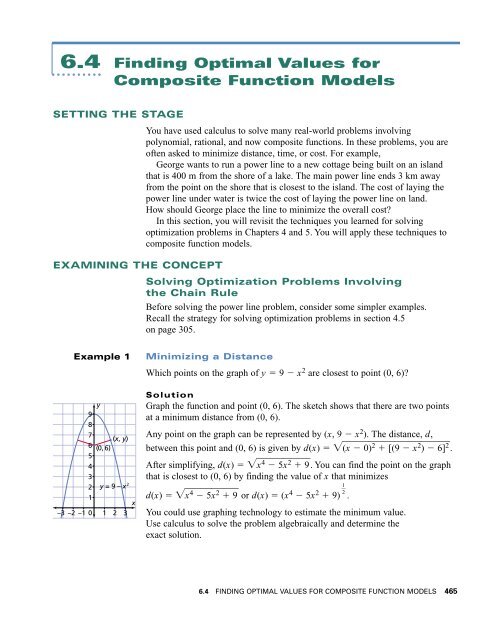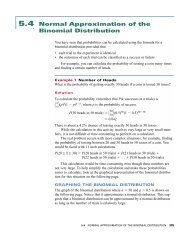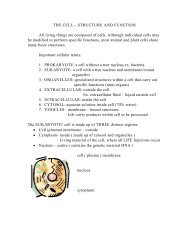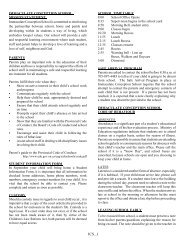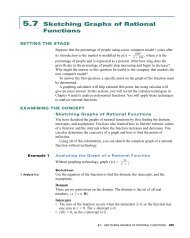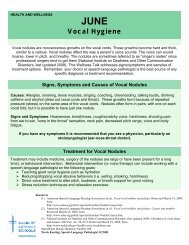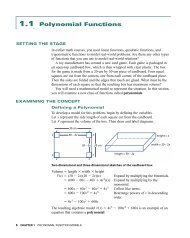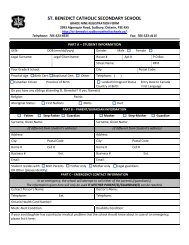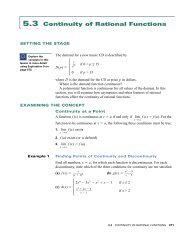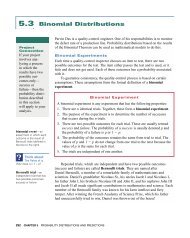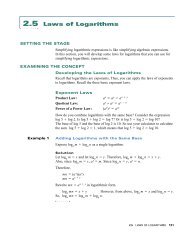Pg 465
Pg 465
Pg 465
Create successful ePaper yourself
Turn your PDF publications into a flip-book with our unique Google optimized e-Paper software.
6.4 Finding Optimal Values for<br />
Composite Function Models<br />
SETTING THE STAGE<br />
You have used calculus to solve many real-world problems involving<br />
polynomial, rational, and now composite functions. In these problems, you are<br />
often asked to minimize distance, time, or cost. For example,<br />
George wants to run a power line to a new cottage being built on an island<br />
that is 400 m from the shore of a lake. The main power line ends 3 km away<br />
from the point on the shore that is closest to the island. The cost of laying the<br />
power line under water is twice the cost of laying the power line on land.<br />
How should George place the line to minimize the overall cost<br />
In this section, you will revisit the techniques you learned for solving<br />
optimization problems in Chapters 4 and 5. You will apply these techniques to<br />
composite function models.<br />
EXAMINING THE CONCEPT<br />
Solving Optimization Problems Involving<br />
the Chain Rule<br />
Before solving the power line problem, consider some simpler examples.<br />
Recall the strategy for solving optimization problems in section 4.5<br />
on page 305.<br />
Example 1<br />
9<br />
8<br />
7<br />
6<br />
5<br />
4<br />
3<br />
2<br />
1<br />
–3 –2 –1 0<br />
y<br />
(x, y)<br />
(0, 6)<br />
y = 9 – x 2<br />
1 2 3<br />
x<br />
Minimizing a Distance<br />
Which points on the graph of y 9 x 2 are closest to point (0, 6)<br />
Solution<br />
Graph the function and point (0, 6). The sketch shows that there are two points<br />
at a minimum distance from (0, 6).<br />
Any point on the graph can be represented by (x, 9 x 2 ). The distance, d,<br />
between this point and (0, 6) is given by d(x) (x ) 09 2 [( ) x 2 6]<br />
2 .<br />
After simplifying, d(x) x x 4 5. 2 9 You can find the point on the graph<br />
that is closest to (0, 6) by finding the value of x that minimizes<br />
d(x) xx 4 5<br />
2 9<br />
or d(x) (x 4 5x 2 9) .<br />
You could use graphing technology to estimate the minimum value.<br />
Use calculus to solve the problem algebraically and determine the<br />
exact solution.<br />
1<br />
2<br />
6.4 FINDING OPTIMAL VALUES FOR COMPOSITE FUNCTION MODELS <strong>465</strong>
d′(x) d<br />
d<br />
x<br />
<br />
(x 4 5x 2 <br />
9) 2<br />
<br />
d(x 4 5x 2 2<br />
9)<br />
<br />
d(x 4 5x 2 9)<br />
1<br />
1<br />
d<br />
• d<br />
(x<br />
x<br />
4 5x 2 9)<br />
Apply the chain rule.<br />
1 2 (x4 5x 2 9) <br />
d<br />
• d<br />
(x<br />
x<br />
4 5x 2 9)<br />
• (4x 3 10x) Factor the numerator.<br />
<br />
2x(2x 2 5)<br />
1<br />
2(x 4 5x 2 9)<br />
2<br />
x(2x 2 5)<br />
Simplify.<br />
<br />
x x 4 5<br />
2 9<br />
The derivative is a rational expression. To find the critical numbers, determine<br />
where d′(x) 0 or d′(x) does not exist. The only case in which d′(x) cannot<br />
exist is when the denominator, x x 4 5, 2 9 is equal to 0. However, this case<br />
cannot occur, as is shown below.<br />
x 4 5x 2 9 x 2 5 2 2 1 1<br />
Complete the square.<br />
4<br />
For all x ∈ R,x 2 5 2 2 ≥ 0.<br />
∴ x2 5 2 2 1 1<br />
> 0<br />
4<br />
1<br />
2(x 4 5x 2 9)<br />
1<br />
2<br />
1<br />
2<br />
∴ x x 4 5 2 9 > 0.<br />
Thus, d′(x) is defined for all values of x ∈ R. Also, d′(x) 0 when the<br />
numerator, x(2x 2 5), equals 0; that is, when x 0 or x ± <br />
5 2 .<br />
Solving x 0 and 2x 2 5 0 produces the critical numbers. Therefore, the<br />
critical numbers are x <br />
5 2 , x 0, and x 5 2 . Apply the first derivative<br />
test to find the critical numbers that represent a local minimum.<br />
Intervals<br />
x < – <br />
5 2 – <br />
5 2 < x < 0 0 < x < 5 2 x > <br />
5 2<br />
x – – + +<br />
(2x 2 – 5) + – – +<br />
xx 4 – 5 2 + 9 + + + +<br />
d′(x) (– )(+<br />
( +<br />
)<br />
)<br />
= – (– )(<br />
( +<br />
–)<br />
)<br />
= + (+ )(<br />
(+ –)<br />
)<br />
= – (+ )(<br />
+)<br />
( = +<br />
+ )<br />
→<br />
d (x) decreasing increasing decreasing increasing<br />
→<br />
minimum at x = – <br />
5 2 maximum at x = 0 minimum at x = 5 2<br />
→<br />
→<br />
466 CHAPTER 6 RATES OF CHANGE IN COMPOSITE FUNCTION MODELS
The first derivative test verifies that a local minimum occurs when x <br />
5 2 or<br />
x <br />
5 2 . These values correspond to the minimum distance. Substitute them<br />
into the original function y 9 x 2 to get the minimum distance, which is the<br />
corresponding value of the function.<br />
y 9 <br />
5 2 2 and y 9 5 2 2<br />
9 5 2 <br />
9 5 2 <br />
1 3 13 <br />
2<br />
<br />
2<br />
The two points closest to (0, 6) on the graph of y 9 x 2 are 5 2 , 1 2<br />
and 5 2 , 1 3<br />
2 .<br />
Note that in this case, the calculator cannot be used to determine an exact<br />
solution, but can be used to check the reasonableness of the solution by<br />
evaluating <br />
5 2 and comparing with the graphs above.<br />
3<br />
<br />
Example 2<br />
Deciding When Two Moving Objects Are Closest<br />
to Each Other<br />
A north–south highway intersects an east–west highway at point P. A vehicle<br />
crosses P at 1:00 p.m., travelling east at a constant speed of 60 km/h. At the<br />
same instant, another vehicle is 5 km north of P, travelling south at 80 km/h.<br />
Find the time when the two vehicles are closest to each other and the distance<br />
between them at that time.<br />
80t<br />
5 – 80t<br />
North<br />
5 km north of P<br />
P<br />
Q<br />
d<br />
60t<br />
R<br />
East<br />
Solution<br />
Draw a diagram. Let the x- and y-axes be the highways, and let P be at the<br />
origin. The slower vehicle is travelling away from P, while the faster<br />
vehicle is travelling toward P.<br />
Let t be the number of hours after 1:00 P.M.<br />
At time t, the slower vehicle is 60t kilometres east of P, and the faster<br />
vehicle is (5 80t) kilometres north of P.<br />
The quantity to be minimized is the distance between the two vehicles, d.<br />
From the diagram and using the Pythagorean theorem,<br />
d 2 (5 80t) 2 (60t) 2<br />
d 2 25 800t 10 000t 2<br />
d 25 00t – 810 t 000<br />
2<br />
∴ d(t) (25 800t 10 000t 2 )<br />
You can estimate the solution graphically, as shown. The minimum<br />
distance, approximately 3 km, occurs at t 0.04.<br />
1<br />
2<br />
6.4 FINDING OPTIMAL VALUES FOR COMPOSITE FUNCTION MODELS 467
Use calculus to calculate the exact solution algebraically. Applying the chain<br />
rule and the power rule,<br />
d′(t) <br />
1 2 (25 800t 10 000t2 ) <br />
d<br />
• d<br />
(25 800t 10 000t<br />
t<br />
2 )<br />
d<br />
• d<br />
(25 800t 10 000t<br />
t<br />
2 )<br />
1 2 (25 800t 10 000t2 ) • (800 20 000t)<br />
<br />
<br />
d(25 800t 10 000t 2 )<br />
2<br />
<br />
d(25 800t 10 000t 2 )<br />
800 20 000t<br />
1<br />
2(25 800t 10 000t 2 )<br />
2<br />
400 10 000t<br />
<br />
25 00t 810 t 000<br />
2<br />
Critical numbers occur when d′(t) 0 or is undefined. Note that the<br />
denominator equals (100t <br />
4) 2 9, which is always greater than 0;<br />
therefore, the derivative is always defined. So, d′(t) 0 when the numerator<br />
equals 0.<br />
∴ 0 400 10 000t<br />
t 0.04<br />
1<br />
Use the first derivative test to verify that t 0.04 represents a local minimum.<br />
The first derivative test confirms that a local minimum occurs when t 0.04.<br />
In this case, the calculator gives the exact solution.<br />
The distance between the vehicles is minimized at this time. The value t 0.04<br />
means 0.04 h, or 0.04 60 2.4 min, or 2 min 24 sec.<br />
Evaluate d when t 0.04 to determine the minimum distance.<br />
d(0.04) 25 00(0.0 84) 0 10.04) 000( <br />
2<br />
3<br />
The two vehicles are closest to each other when they are 3 km apart at exactly<br />
1:02:24 P.M.<br />
1<br />
2<br />
1<br />
2<br />
Intervals<br />
0 ≤ t < 0.04 t > 0.04<br />
–400 + 10 000t – +<br />
25 00t – 810 + 0t 00 2 +<br />
(–)<br />
d′(t) (<br />
= – ( + )<br />
= +<br />
+ )<br />
( + )<br />
d(t) decreasing increasing<br />
→<br />
minimum at x = 0.04<br />
→<br />
468 CHAPTER 6 RATES OF CHANGE IN COMPOSITE FUNCTION MODELS
Example 3<br />
Minimizing the Cost of an Electrical Power Line<br />
Recall the problem in Setting the Stage.<br />
George wants to run a power line to a new cottage being built on an island<br />
that is 400 m from the shore of a lake. The main power line ends 3 km away<br />
from the point on the shore that is closest to the island. The cost of laying the<br />
power line under water is twice the cost of laying the power line on land. How<br />
should George place the line to minimize the overall cost<br />
Solution<br />
Sketch a diagram of the situation. The cable will run along the shore, enter the<br />
water at some point, and continue straight to the island.<br />
400 m<br />
3000 m<br />
end of existing<br />
power line<br />
x<br />
L1<br />
L 2<br />
1 2<br />
Let x represent the distance between the point on the shore closest to the island<br />
and the point where the cable enters the water. Let L 1<br />
represent the length of<br />
cable underwater and L 2<br />
the length of cable on land. Therefore, the total cost to<br />
lay the cable is C 2L 1<br />
L 2.<br />
Minimize this quantity, C.<br />
From the diagram, L 2<br />
3000 x and (L 1<br />
) 2 x 2 400 2 , so<br />
L 1<br />
x 60 2 1. 000 Substituting in the expression for C gives<br />
C(x) 2(x 60 2 1) 000 (3000 x)<br />
∴ C(x) 2(x 2 160 000) (3000 x) 0 ≤ x ≤ 3000<br />
You can estimate the minimum value using graphing technology.<br />
Now use calculus to calculate the exact solution algebraically.<br />
Using the difference and chain rules,<br />
C′(x) d<br />
d<br />
x<br />
2(x 2 160 000) d<br />
d[2(x 2 160 000) ]<br />
d(x 2 160 000)<br />
d<br />
x<br />
d<br />
(3000) d<br />
(x)<br />
C′(x) • 0 1<br />
2 1 2 (x2 160 000) <br />
(x 2 160 000) • 2x 1<br />
2x<br />
1<br />
2<br />
1<br />
2<br />
d(x 2 160 000)<br />
dx<br />
d<br />
• d<br />
(x<br />
x<br />
2 160 000) 1<br />
<br />
1<br />
x 60 2 1000<br />
Critical numbers occur when C′(x) equals 0 or is undefined. In this case, the<br />
denominator is always greater than 0, so C′(x) is defined for all x where<br />
0 < x < 3000. Solve for x to determine where C′(x) 0.<br />
1 2<br />
1 2<br />
x<br />
6.4 FINDING OPTIMAL VALUES FOR COMPOSITE FUNCTION MODELS 469
2x<br />
<br />
x 60 2 1000<br />
2x<br />
<br />
x 60 2 1 000<br />
1 0<br />
1<br />
<br />
2x x 60 2 1000<br />
4x 2 x 2 160 000<br />
3x 2 160 000<br />
00<br />
0<br />
x ± <br />
160 3<br />
x 230.94<br />
<br />
Add 1 to each side.<br />
Multiply each side by x 60 2 1.<br />
000<br />
Square both sides.<br />
Isolate x 2 .<br />
Solve for x.<br />
Since x ≥ 0, the negative solution is<br />
inadmissible.<br />
Intervals<br />
0 ≤ x < 230.94 230.94 < x ≤ 3000<br />
C ′(x) – +<br />
C(x) decreasing increasing<br />
The first derivative test confirms that a global minimum occurs at x 230.94.<br />
This value is the distance from the point on the shore closest to the island to the<br />
point where the cable enters the water. This distance will minimize the cost of<br />
installing the cable. Using this value, calculate L 1<br />
and L 2<br />
.<br />
L 1<br />
(230.9 4) 160 2 0 00 L 2<br />
3000 230.94<br />
461.88 2769.06<br />
The total cost of laying the cable is minimized if about 2769.06 m are placed<br />
along the shore and 461.88 m are placed underwater.<br />
→<br />
minimum at x = 230.94<br />
→<br />
CHECK, CONSOLIDATE, COMMUNICATE<br />
1. Why do optimization problems involving distance often result in using<br />
the chain rule<br />
2. Suppose you have found the model for a problem. Is determining the<br />
optimal values of a composite function different from determining the<br />
optimal values for polynomial and rational functions Explain your<br />
answer in terms of techniques.<br />
KEY IDEAS<br />
• The properties of the derivative that you use to solve optimization<br />
problems involving composite functions are the same as those you apply<br />
to polynomial and rational functions.<br />
• Use the strategy for solving optimization problems, outlined in Chapters 4<br />
and 5 on pages 305 and 397, to also solve problems involving composite<br />
function models.<br />
470 CHAPTER 6 RATES OF CHANGE IN COMPOSITE FUNCTION MODELS
6.4 Exercises<br />
A<br />
1. Find the point on the line y 6x 8 that is closest to the origin, (0, 0).<br />
2. What point on the graph of f (x) x 2 is closest to (2, 0.5)<br />
3. Find the point on the curve 2y 2 4(x 1) that is closest to the origin.<br />
4. Ship A, sailing due east at 8 km/h, sights ship B 5 km to the southeast when<br />
ship B is sailing due north at 6 km/h. How close to each other will the two<br />
ships be when they pass<br />
5. Mike, who is standing on the deck of a yacht that is travelling due west at<br />
6 km/h, sees a sailboat sailing southwest at 4 km/h, 3 km northwest of the<br />
yacht. How close to each other do these boats get<br />
6. Knowledge and Understanding: Determine the points on the curve<br />
y x, 0≤ x ≤ 1, that are (a) closest to and (b) farthest from point (2, 0).<br />
B<br />
7. A passenger jet is travelling due north at 400 km/h, while a cargo plane,<br />
2 km to the northwest, is travelling east at 300 km/h. The altitude of the<br />
cargo plane is 1000 m lower than the altitude of the passenger jet. What will<br />
be the minimum separation between the two aircraft<br />
8. A truck travelling west at 100 km/h is 250 km due east of a sports car going<br />
north at 120 km/h. When will the vehicles be closest to each other What is<br />
the minimum distance between them<br />
9. A boat leaves a dock at 2:00 P.M., heading west at 15 km/h. Another boat<br />
heads south at 12 km/h and reaches the same dock at 3:00 P.M. When were<br />
the boats closest to each other<br />
West<br />
R<br />
North<br />
100t<br />
Q<br />
10 km<br />
d 10 – 100t<br />
P<br />
80t<br />
10. Communication: Devise an optimization problem based on the diagram on<br />
the left.<br />
11. A woman lives on an island 2 km from the mainland. Her fitness club is<br />
4 km along the shore from the point closest to the island. To get to the<br />
fitness club, she paddles her kayak at 2 km/h. Once she reaches the shore,<br />
she jogs at 4 km/h. Determine where she should land to reach her fitness<br />
club in the shortest possible time.<br />
12. A dune buggy is on a straight desert road, 40 km north of Dustin City. The<br />
vehicle can travel at 45 km/h off the road and 75 km/h on the road. The<br />
driver wants to get to Gulch City, 50 km east of Dustin by another straight<br />
road, in the shortest possible time. Determine the route he should take.<br />
13. Suppose you are swimming in a lake and find yourself 200 m from shore.<br />
You would like to get back to the spot where you left your towel, which is<br />
at least 200 m down the beach, as quickly as possible. You can walk along<br />
the beach at 100 m/min, but you can swim at only 50 m/min. To what point<br />
on the beach should you swim to minimize your total travelling time<br />
6.4 FINDING OPTIMAL VALUES FOR COMPOSITE FUNCTION MODELS 471
Ancaster<br />
4<br />
rest<br />
stop<br />
C 8<br />
Dundas<br />
D<br />
C<br />
6<br />
14. The owners of a small island want to bring in electricity from the mainland.<br />
The island is 80 m from a straight shoreline at the closest point. The nearest<br />
electrical connection is 200 m along the shore from that point. It costs twice<br />
as much to install cable across water than across land. What is the least<br />
expensive way to install the cable<br />
15. Application: Bill owns an oil well located 400 m from a road. Bill wants<br />
to connect the well to a storage tank 1200 m down the road from the well.<br />
It costs $35/m to lay pipe along the road and $50/m to lay it elsewhere.<br />
How should the pipeline be laid to minimize the total cost<br />
16. Thinking, Inquiry, Problem Solving: Find the dimensions of the rectangle of<br />
x<br />
2 2<br />
maximum area that can be inscribed in the ellipse 1<br />
1.<br />
y 6 9<br />
17. Check Your Understanding: Is the strategy for solving optimization<br />
problems different for rational and composite function models Explain.<br />
18. An offshore oil well is in the ocean at a point 5 km from the closest point<br />
on a straight shoreline. The oil must be pumped from the well to a storage<br />
facility on shore. The storage facility is 15 km away from the point on shore<br />
that is closest to the well. It costs $100 000/km to lay pipe underwater and<br />
$75 000/km over land. How should the pipeline be situated on the shore to<br />
minimize the cost<br />
19. Prove that (1, 0) is the closest point on the circle x 2 y 2 1 to (2, 0).<br />
20. Two towns, Ancaster and Dundas, are 4 km and 6 km, respectively, from<br />
an old railroad line that has been made into a bike trail. Points C and D<br />
on the trail are the closest points to the two towns, respectively. These<br />
points are 8 km apart. Where should a rest stop be built to minimize the<br />
length of new trail that must be built from both towns to the rest stop<br />
ADDITIONAL ACHIEVEMENT CHART QUESTIONS<br />
Knowledge and Understanding: A north–south highway intersects an east–west<br />
highway at point P. A vehicle passes P at 3:00 P.M., travelling east at a constant<br />
speed of 100 km/h. At the same instant, another vehicle passes 2 km north of P,<br />
travelling south at 80 km/h. Find the time when the two vehicles are closest to<br />
each other and when the distance between them is minimal.<br />
10 km<br />
Application: Millie is in a boat 2 km from a straight shoreline and wants to reach<br />
a point on the shore 10 km north of her present position, as shown in the<br />
diagram. She can row at 5 km/h and jog at 8 km/h. Calculate the position on the<br />
shoreline to which she should row to reach the destination in the shortest time.<br />
Thinking, Inquiry, Problem Solving: Find the area of the largest rectangle that<br />
can be inscribed in a circle with radius r.<br />
2 km<br />
Communication: To solve an optimization problem, you set the derivative of the<br />
function that models the problem to 0 and solve the resulting equation. Why<br />
472 CHAPTER 6 RATES OF CHANGE IN COMPOSITE FUNCTION MODELS


